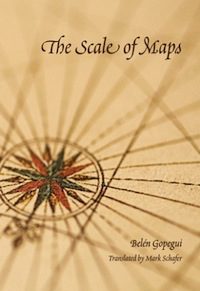
The most indispensable writer of the 20th century, Jorge Luis Borges, included a short story about a mythic map in A Universal History of Infamy. The story is about one hundred words long and concerns a “Map of the Empire whose size was that of the Empire, and which coincided point for point with it.” The map is impractical and the imperial advisors discard it. In the end, both the discarded map and the incomplete story are cast as Ozymandias-type fragments:
In the Deserts of the West, still today, there are Tattered Ruins of that Map, inhabited by Animals and Beggars; in all the Land there is no other Relic of the Disciplines of Geography.
Cartography as quixotic undertaking is also a theme of the indelible first novel of Belén Gopegui, a Madrid-based writer. The Scale of Maps, owing partly to its short, honed chapters, is brisk, taut storytelling. Its protagonist-narrator, Sergio Prim, describes his unusual love affair with another cartographer, his troubles at work, and the metaphysical debates he has with other mapmakers. Throughout the novel he openly questions both his own psychological reliability and ability to handle human relationships. At times, he clearly fabricates conversations and events. This novel of ideas never feels contrived or schematic.
As in Rivka Galchen’s Atmospheric Disturbances or John Lanchester’s great The Debt to Pleasure, the first-person narrator is mad, and his madness defamiliarizes the banal rituals of intimacy. Throughout the novel, Sergio Prim, a quixotic mapmaker in the Borgesian tradition, makes repeated claims for the explanatory power of myth, abstraction, and non-empirical truths. As a geographer and as a madman, he blurs the line between sign and referent.
It leads Sergio to produce off-kilter flourishes like this: “I have always liked examining people’s topographical features, catching them unawares as they rest their hands in a moment of inattention, their sonorous and pensive profile or their black moustache, their dark tragedy.”

The reader comes to realize that the narrator’s intellectualism is a self-defense mechanism. He describes himself this way: “I am Albania. My natural climate is temperate, it is composed of scraps of unsanitary plains, rugged plateaus, and a collection of abrupt mountains. In my republic, we practice the autarchy of retreat: production for the purpose of self-sufficiency and to protect ourselves from foreign influence.”
Sergio is preoccupied by a theory of the “hollow”—a negative space that gives order and meaning to his life. As a geographer, he compares it to the time before maps, before the first world map created by Anaximander, when the world was “exaggerated and self-absorbed.” He is paralyzed by doubt, though no less loquacious for it: “Circumstances always get the better of men. I completely understand those admirals who never manage to engage a single ship in battle, who fight the elements their whole lives long.”
The woman that the protagonist pines for is Brezo Varla, whose smile “is as wide as a gong.” Here, Gopegui, a committed Marxist, is playing some of the same post-modern name games that have come down to us through Pynchon. In Spanish, “Brezo” means “to fall asleep,” and Varla is the name of a 19th-century priest in Cuba whose name has been taken up by an organization calling for political reform there.
Shafer’s translation recreates the humor and intelligence of Gopegui’s novel. The Spaniard’s humor is distinctly literary, always specific, and never condescending. By taking up the evocative language of geography—its “errors in scale,” the “architects of utopias”—Gopegui runs the risk of dull metaphor, but her narrative instincts are sharp enough to avoid that pitfall. Instead, gratefully, Brezo or Dona Elena, Sergio’s supervisor, are wry foils to Sergio’s grand theories.
At one point, Sergio Prim tells Brezo, “Don’t believe anything because, at the least, you will be protecting a sensitive, almost liquid, shifting, and turbulent system that is somewhat mysteriously called your sense of humor.”
The novelists Roberto Bolaño and Francisco Umbral and the critic Idoya Puig are not alone in placing Gopegui among the finest Spanish-language writers working today. After The Scale of Maps made a splash on the Spanish-language literary scene in 1993, she went on to write over ten other novels, including The Conquest of the Air (1998) and The Father of White (2007), though unfortunately only The Scale of Maps is available in English. She shares some of the rueful tone and brazen stylistic improvisations of her contemporaries, Enrique Vila-Matas and Javier Marias, but her work has taken much longer to find its way into Anglophone bookstores.
In an interview in El Mundo, Gopegui asked which of her books to start with and she answered The Scale of Maps, “if you are interested in the possibility of intervening and changing reality.” Perhaps a translator is churning out pages of her other celebrated novels as I write. The Scale of Maps is a rapturous and dazzling achievement, and I, for one, am waiting impatiently for the opportunity to read more of Gopegui.




